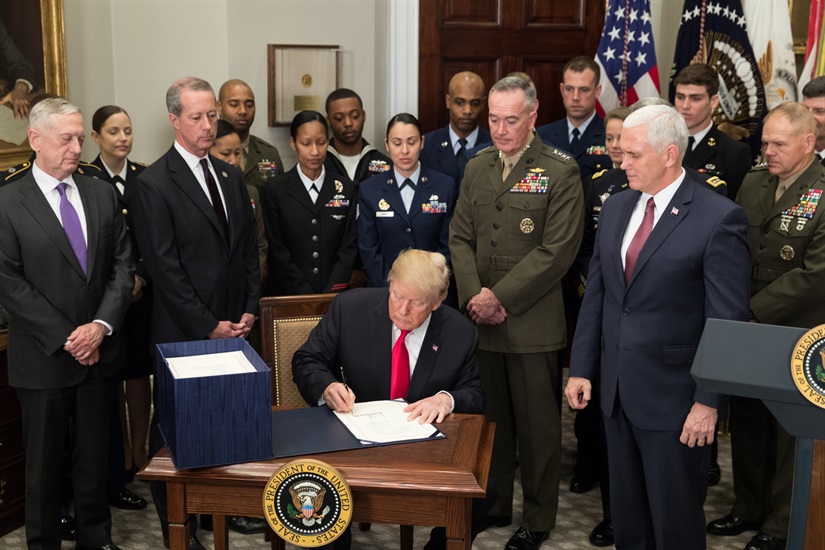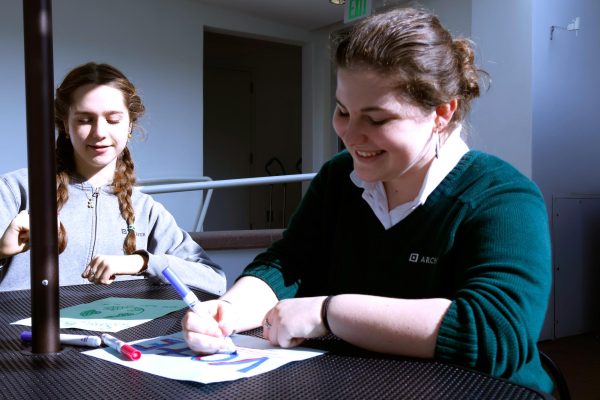Shutdowns in space: What Mars rovers and NASA scientists have in common
Photo credit: White House photo by Stephanie Chasez
President Donald J. Trump, joined by Vice President Mike Pence and senior military leaders, signs the National Defense Authorization Act for 2018 on Dec. 12, 2017. Due to the Government Shutdown many United States agencies were without funding for 35 days.
After 15 years of exploring the red planet, the Mars Opportunity rover died Feb. 12. After the rover team’s attempt to contact it on Tuesday was unanswered, NASA shut down Opportunity’s mission.
This, however, was not the only shutdown NASA was concerned about this week. The government agency was facing another possible government shutdown. Although President Trump signed a spending bill today before funding expired, NASA workers may still be concerned about funding for their programs.
During the first partial government shutdown, which lasted 35 days from Dec. 22 to Jan. 25, as many as 800,000 government agents were furloughed. This included 16,700 NASA employees which, according to the Houston Chronicle, “account[ed] for 96 percent of the [NASA] workforce.”
One of those workers was Paul Niles, a planetary scientist at NASA’s Johnson Space Center and brother-in-law of history teacher Kathleen Niles. In a phone interview with the Oracle in January, Paul Niles described the impact that the first shutdown was having on his program at the time.
“I work with scientists who work on missions that are on the surface of Mars and orbiting Mars and the moon,” Niles said during the shutdown. “None of those scientists can participate in work right now.”
He said NASA and other government agencies were unable to pursue projects that have been in progress for decades.
“Something I’m working on is the commercial lander program that hopes to send robot missions to the moon by 2019 or 2020,” Niles said. “We have a program where we are trying to find commercial companies like Blue Origin or other companies to build the spaceships to get the robots to the moon. And all of that work is stopped. There are huge multi-billion dollar projects on delay right now.”
Niles also said although only 30 percent of NASA employees work directly for the government, the other 60 percent are contractors, and their contracts were running out of money.
“The biggest effect for [the contractors] is that those contracts are funded for about a month at a time, and the money is running out on their January contract,” Niles said. “There’s no money to refill it. In order to try and prolong the money, they are starting to cut people back by telling people not to work and moving people to part-time. Those people don’t get [fully] paid back at the end — it’s permanent income loss.”
Although the 2018-19 government shutdown was the longest the United States government has ever been shut down, it has happened before. Having worked at NASA during the 2013 government shutdown, Niles reflected on the uncertain nature of this year’s shutdown.
“I think the biggest difference is that it’s unclear when it’s going to end,” Niles said. “This feels like it’s going to last a lot longer than a few weeks, or even the month that it’s been. “
Although the government re-opened shortly after this interview, NASA employees faced the possibility of a second shutdown on Feb. 15 until Trump signed the spending bill. He also declared a national state of emergency to circumvent Congress’ decision not to fully fund the wall.
“If we had a wall, we don’t need the military, because we’d have a wall,” President Trump said in a speech at the Rose Garden. “So I’m going to be signing a national emergency.”
Although a second shutdown was averted, Paul Niles said the first shutdown left him unsure about how much the country values NASA and other government agencies.
“I think that one of the things that bothers me the most is that this sort of makes all the work that we do seem unimportant,” Niles said. “It seems like you can just turn it off and that no one will care. As a country I feel like NASA is one of our priorities, it’s one of the things we do really well, and if you just turn it off, it feels like the country just doesn’t really care about it.”

Nicki Rosenberg joined the Oracle in 2017 and was then promoted to Managing Editor as a junior. This year she will continue serving as the Managing Editor...













